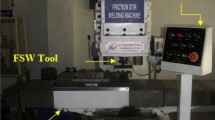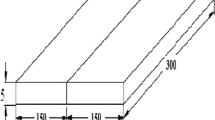Abstract
Understanding the flow of plasticized material during friction stir welding was critical for producing quality welds. The tool geometry such as shoulder and pin designs play a significant role in altering the material flow characteristics. In the present investigation, scroll shoulder design with varying pins were addressed in the aspects of tool axial force, material flow and mechanical properties. Marker insert method was used to study the flow of plasticized material with copper as inserts. The results show that the pin geometry variation has showed a significant change in the axial force plot in the welding phase. The taper cylindrical pin tool (TS) facilitated a constant force, hexagonal pin (TS)H and pentagonal pin (TS)P tools facilitated a decreasing force behavior, and triangular pin designed tool (TS)T facilitated an increasing behavior of force in the welding phase. The material flow experiments showed that the scroll shoulder with triangular pin shaped tool (TS)T completely sheared the marker inserts in both parallel and perpendicular to weld conditions compared to other pin shapes. The sheared copper fragments were uniformly distributed on both advancing and retreating sides of the weld for (TS)T tool. Superior mechanical properties were noticed for (TS)T tool with a tensile strength of 184 MPa and Microhardness of 78 HV at stir zone.
Graphic Abstract














Similar content being viewed by others
References
R.S. Mishra, M.W. Mahoney, Friction stir welding and processing. ASM Int. (2007). https://doi.org/10.1361/fswp2007p001
W. Thomas, E. Nicholas, Friction stir welding for the transportation industries. Mater. Des. 18, 269–273 (1997). https://doi.org/10.1016/S0261-3069(97)00062-9
R. Nandan, T. Debroy, H. Bhadeshia, Recent advances in friction-stir welding—process, weldment structure and properties. Prog. Mater. Sci. 53, 980–1023 (2008). https://doi.org/10.1016/j.pmatsci.2008.05.001
A. Arora, A. De, T. DebRoy, Toward optimum friction stir welding tool shoulder diameter. Scr. Mater. 64, 9–12 (2011). https://doi.org/10.1016/j.scriptamat.2010.08.052
H. Schmidt, J. Hattel, J. Wert, An analytical model for the heat generation in friction stir welding. Model. Simul. Mater. Sci. Eng. 12, 143–157 (2004). https://doi.org/10.1088/0965-0393/12/1/013
L. Cederqvist, C.D. Sorensen, A.P. Reynolds, T. Oberg, Improved process stability during friction stir welding of 5 cm thick copper canisters through shoulder geometry and parameter studies. Sci. Technol. Weld. Join. 14, 178–184 (2009). https://doi.org/10.1179/136217109X400420
Y. Huang, Y. Wang, L. Wan, H. Liu, J. Shen, J.F. Dos Santos, L. Zhou, J. Feng, Material-flow behavior during friction-stir welding of 6082-T6 aluminum alloy. Int. J. Adv. Manuf. Technol. (2016). https://doi.org/10.1007/s00170-016-8603-7
I. Galvao, R.M. Leal, D.M. Rodrigues, A. Loureiro, Influence of tool shoulder geometry on properties of friction stir welds in thin copper sheets. J. Mater. Process. Technol. 213, 129–135 (2013). https://doi.org/10.1016/j.jmatprotec.2012.09.016
A. Scialpi, L.A.C. De Filippis, P. Cavaliere, Influence of shoulder geometry on microstructure and mechanical properties of friction stir welded 6082 aluminium alloy. Mater. Des. 28, 1124–1129 (2007). https://doi.org/10.1016/j.matdes.2006.01.031
R.M. Leal, C. Leitao, A. Loureiro, D.M. Rodrigues, P. Vilaça, Material flow in heterogeneousfriction stir welding of thin aluminium sheets: effect of shoulder geometry. Mater. Sci. Eng. A 498, 384–391 (2008). https://doi.org/10.1016/j.msea.2008.08.018
K.K. Mugada, K. Adepu, Influence of tool shoulder end features on friction stir weld characteristics of Al–Mg–Si alloy. Int. J. Adv. Manuf. Technol. 99, 1553–1566 (2018). https://doi.org/10.1007/s00170-018-2602-9
K.K. Mugada, K. Adepu, Role of tool shoulder end features on friction stir weld characteristics of 6082 aluminum alloy. J. Inst. Eng. Ser. C 100, 343–350 (2019). https://doi.org/10.1007/s40032-018-0451-9
K.K. Mugada, K. Adepu, Influence of shoulder diameter on temperature and Z-parameter during friction stir welding of Al 6082 alloy. IOP Conf. Ser. Mater. Sci. Eng. 330, 012069 (2018). https://doi.org/10.1088/1757-899X/330/1/012069
K.K. Mugada, K. Adepu, Influence of ridges shoulder with polygonal pins on material flow and friction stir weld characteristics of 6082 aluminum alloy. J. Manuf. Process. 32, 625–634 (2018). https://doi.org/10.1016/j.jmapro.2018.03.034
K.K. Mugada, K. Adepu, Effect of knurling shoulder design with polygonal pins on material flow and mechanical properties during friction stir welding of Al–Mg–Si alloy. Trans. Nonferrous Met. Soc. China 29, 2281–2289 (2019). https://doi.org/10.1016/s1003-6326(19)65134-4
M. Yang, R.J. Bao, X.Z. Liu, C.Q. Song, Thermo-mechanical interaction between aluminum alloy and tools with different profiles during friction stir welding. Trans. Nonferrous Met. Soc. China 29, 495–506 (2019). https://doi.org/10.1016/s1003-6326(19)64958-7
A. Tongne, C. Desrayaud, M. Jahazi, E. Feulvarch, On material flow in friction stir welded Al alloys. J. Mater. Process. Technol. 239, 284–296 (2017). https://doi.org/10.1016/j.jmatprotec.2016.08.030
K. Elangovan, V. Balasubramanian, Influences of tool pin profile and tool shoulder diameter on the formation of friction stir processing zone in AA6061 aluminium alloy. Mater. Des. 29, 362–373 (2008). https://doi.org/10.1016/j.matdes.2007.01.030
R. Jain, S.K. Pal, S.B. Singh, Investigation on effect of pin shapes on temperature, material flow and forces during friction stir welding: a simulation study. Proc. Inst. Mech. Eng. Part B J. Eng. Manuf. (2018). https://doi.org/10.1177/0954405418805615
K. Elangovan, V. Balasubramanian, M. Valliappan, Effect of tool pin profile and tool rotational speed on mechanical properties of friction stir welded AA6061 aluminium alloy. Mater. Manuf. Process. 23, 251–260 (2008). https://doi.org/10.1080/10426910701860723
Z. Sun, C.S. Wu, A numerical model of pin thread effect on material flow and heat generation in shear layer during friction stir welding. J. Manuf. Process. 36, 10–21 (2018). https://doi.org/10.1016/j.jmapro.2018.09.021
V.M. Khojastehnezhad, H.H. Pourasl, R. Vatankhah Barenji, Effect of tool pin profile on the microstructure and mechanical properties of friction stir processed Al6061/Al2O3—TiB2 surface hybrid composite layer. Proc. Inst. Mech. Eng. Part L J. Mater. Des. Appl. 233, 900–912 (2019). https://doi.org/10.1177/1464420717715048
H. Khodaverdizadeh, A. Heidarzadeh, T. Saeid, Effect of tool pin profile on microstructure and mechanical properties of friction stir welded pure copper joints. Mater. Des. 45, 265–270 (2013). https://doi.org/10.1016/j.matdes.2012.09.010
M. Imam, K. Biswas, V. Racherla, Effect of weld morphology on mechanical response and failure of friction stir welds in a naturally aged aluminium alloy. Mater. Des. 44, 23–34 (2013). https://doi.org/10.1016/j.matdes.2012.07.046
M. Mehta, A. De, T. DebRoy, Material adhesion and stresses on friction stir welding tool pins. Sci. Technol. Weld. Join. 19, 534–540 (2014). https://doi.org/10.1179/1362171814y.0000000221
C. Venkata Rao, G. Madhusudhan Reddy, K. Srinivasa Rao, Microstructure and pitting corrosion resistance of AA2219 Al–Cu alloy friction stir welds—effect of tool profile. Def. Technol. 11(2015), 123–131 (2015). https://doi.org/10.1016/j.dt.2014.10.003
A. Amirafshar, H. Pouraliakbar, Effect of tool pin design on the microstructural evolutions and tribological characteristics of friction stir processed structural steel. Meas. J. Int. Meas. Confed. 68, 111–116 (2015). https://doi.org/10.1016/j.measurement.2015.02.051
H. Su, C. Wu, Determination of the traverse force in friction stir welding with different tool pin profiles. Sci. Technol. Weld. Join. 24, 209–217 (2019). https://doi.org/10.1080/13621718.2018.1512738
Author information
Authors and Affiliations
Corresponding author
Additional information
Publisher's Note
Springer Nature remains neutral with regard to jurisdictional claims in published maps and institutional affiliations.
Rights and permissions
About this article
Cite this article
Mugada, K.K., Adepu, K. Role of Scroll Shoulder and Pin Designs on Axial Force, Material Flow and Mechanical Properties of Friction Stir Welded Al–Mg–Si Alloy. Met. Mater. Int. 27, 2809–2820 (2021). https://doi.org/10.1007/s12540-020-00623-x
Received:
Accepted:
Published:
Issue Date:
DOI: https://doi.org/10.1007/s12540-020-00623-x




